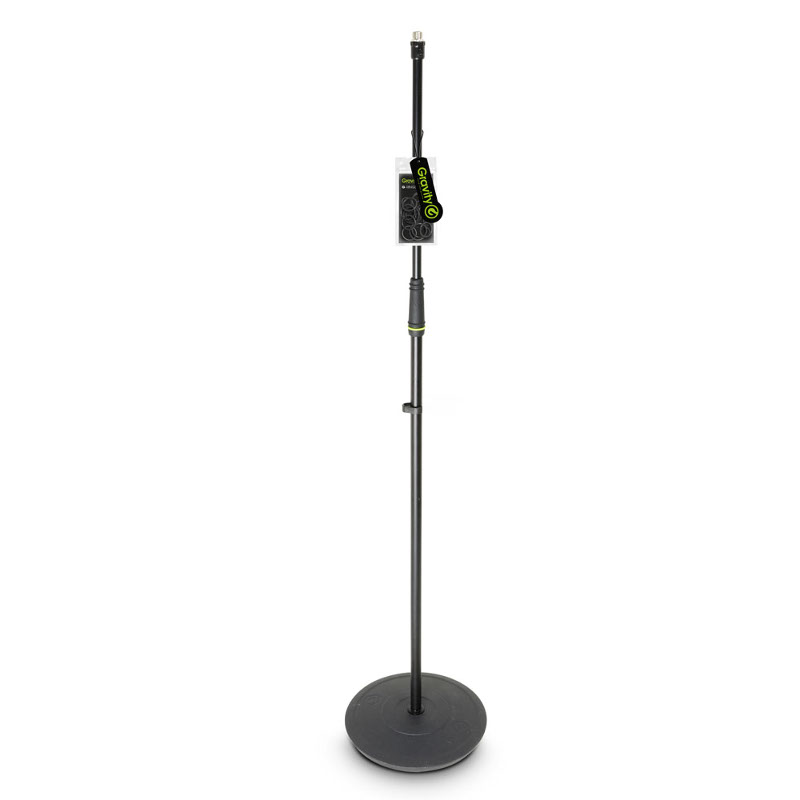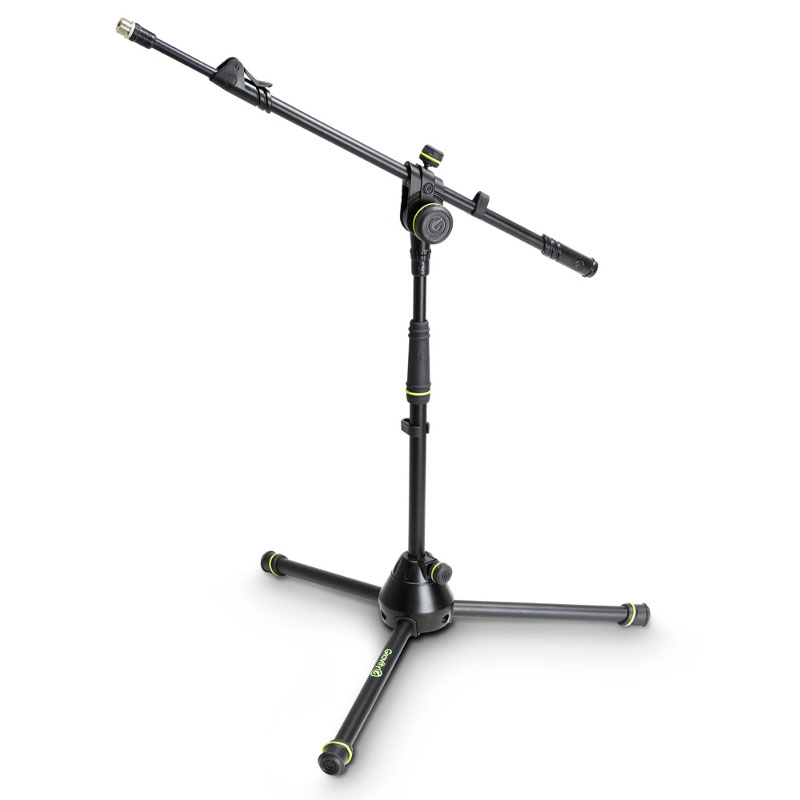Gravity Stands – Review published on Musiker-Board.de
There has been an advertisement on the Musicians Board for quite some time, with a fresh-looking green apple and an equally green G. I don’t think I’m the only one who has been a bit curious about this. It turns out the advertised products are part of a new brand for stands for microphones, speakers, and instruments. The Gravity brand belongs to Adam Hall. The Musicians Board made it possible for me to test three items from this range.

The stands reached me boxed as new. The packaging is purposeful, but not overdone. All of the stand parts are packed separately in plastic bags, which are in turn placed in the cardboard box. The first thing I noticed, was that it was packed completely without adhesive tape, meaning that unpacking and assembling it was a cinch.
First impressions: fresh, modern, somehow unique!
But let’s be honest here, what can you really do with a stand that isn’t already done by one on the market? The stands are normal black ones, and the operation is pretty standard. All the operational elements are where you expect them. There are these green rings though, which gives the stand an individual touch.
MS 23 Round Base Stand
The MS 23 is a round base stand with a cast iron base measuring around 27 cm in diameter. The height is adjustable from 91 to 158 cm. The stand weighs 4.2 kg. When a microphone is mounted onto the stand, such as the LD Systems D1011 that I tested, you can create such a height that the horizontally aligned microphone is suited for singers up to 1.85 m in height.

The weight of the base is large enough to put a stand fitted with said LD microphone safely back into the stand, whilst still at a 25° angle. The stand is best suited to stage use. The height is adjusted via a slightly tapered rotating ring that is screwed in to clamp it into position. The microphone stand is fitted with the usual 3/8 “thread. In addition, each stand comes with a 3/8″ female thread to 5/8” male thread adapter. That’s great, they do tend to go missing every now and then.

At the point where other stands usually have a relatively flat disc with female thread for tightening the mic clamp bracket, the Gravity MS 23 instead has a plastic sleeve screwed onto the thread.

MS 4222 B Tripod
This is a medium-sized tripod. The instrumental microphone is usually used for drums, percussion, wind instruments, and various instrumental amplifiers. The three legs form a contact area with a radius of about 29 cm. The stand has a total weight of 2.2 kg most of which probably is down to the very solid base made from die cast zinc. The stand column clamp is effective and not abrasive.

The height is adjusted using the same conical clamping ring as the MS 23 round base stand, and it means that the stand can be adjusted from 44 cm to 67 cm without the boom. The boom itself is also adjustable in length from 52 cm to 87 cm. The length is adjusted and secured via an effective and functional clamping lever. Overall, when the actual stand is fully extended, along with the boom, the maximum height is 149 cm. However, that’s probably not what’ll happen in practice, as in that case you would normally opt for a larger stand.

MS 4322 B Tripod
All in all, this tripod has the same features as the smaller MS 4222 B, with the only difference being that the height can be adjusted from 94 cm to 161 cm. Together with the same boom, as already described for the MS 4222 B, it can reach a maximum height of 245 cm, or, as is presumably intended, can be used as an overhead microphone for larger instruments when combined with the boom.

The length adjustment clamping on the boom is on the main joint, and is done via a screw, which in turn acts on a plastic part. This means it can be secured in a safe manner that also ensures that the part is not damaged.
All of the stands include a set of black rubber replacement rings, if you find the green rings not to your taste. Rings are also available for the stand in eight other colours, designed to differentiate between special applications, or just to make your own inventory easier to recognise.
This is how the stands fared in our tests:
I tried the stands out in two gigs and a few sample runs. Any wear or abrasion, especially in the fixing elements, was hardly detectable. The rubbery feet means that the stand doesn’t slip at all when placed on various floor types (wood, stone, carpet). The round base plate can also be used for this purpose, and to protect more sensitive floor types.
When we assembled and disassembled the stands, we noticed that all of the clamps and fittings were easy to fit, but also fared well when tightened a little more. Some people in my circle of friends mentioned to me afterwards that I tend to tighten screws more than is necessary. But it was easy to unscrew them in any case.
The screws for the base, gantry angle and boom extension length were made using the 2K injection moulding process (with injected metal threads). There is a rubberised surface on the base, which ensures good grip, but is also ergonomically pleasant to handle. I certainly didn’t miss the clamp screws that other stands use. You only have to unscrew the screw a little bit to adjust the angle, and it makes a slight crunching noise. It doesn’t make any further noise when you unscrew it looser. This noise is a clear indication that there is a rubber liner in the joint. This means that the whole joint feels softer/gentler when you adjust it, but it is also possible to secure without using excessive torque and it doesn’t unintentionally shift.
I had a lot of fun testing it, and I decided to see what the 95 cm long extension stand would feel like. I screwed the extension onto the already fully extended boom on the mid-size round plate stand, and adjusted it horizontally. The stand didn’t tip over, nor did the boom sink to the ground. It was an extreme way to test it, which wouldn’t really apply in practice, but it certainly shows off the stability of the stand. The stand feet sit well in the base and are free of play.
In practice, the plastic sleeve that I described above made a positive impression. I’ve come across so many stands where if you loosen the screws on the stand boom, then the whole thing starts to wobble. You even see it sometimes with professionals that the microphone starts to wobble on the boom during a show, and then starts to slip due to gravity.
This is where the plastic sleeve comes in pretty useful. Each screw works because the screw, or the tension created in the screw, creates enough friction in the thread that the screw can no longer come loose. This is facilitated by spring elements, such as spring or serrated washers. However, the plastic sleeve also has the same effect, as it slightly compresses the screw, and therefore builds the necessary tension. It’s a small part, but it’s quite important. When used previously, the screw didn’t come accidentally loose, and all of the microphones remained in exactly the same positions as when they were set up.
Conclusion:
In summary, I feel the stands are a bit unspectacular with regards to performance. They simply work and function reliably. However, it is worth noting as a plus that this is due to the significantly lower prices of the stands than those that are usually referred to as the “standard” here on the Musicians Board.
Only a longer test will show how the stands cope with continuous use. Since my test subjects were provided by Adam Hall on loan, I’m curious as to what other users make of them in the near and distant future. The black surface (presumably powder coating?) is also interesting. When I look at older stands in my inventory, you can see clear traces of wear on them, from both use and transport, irrespective of their price.
__________________________________
Source: musiker-board.de; Nov 2015, Germany: http://www.musiker-board.de/threads/test-gravity-mikrofonstative.624324/#post-7661139
Click here to learn more about Gravity Stands:
http://www.gravitystands.com/
Leave a Comment
You must be logged in to post a comment.












